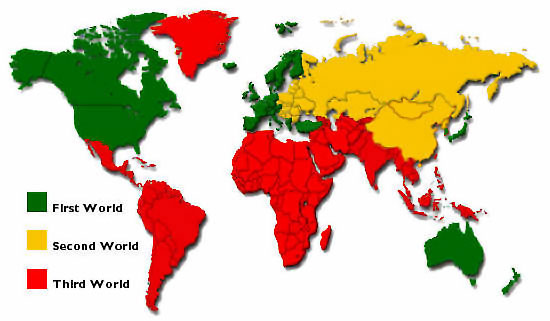___ First, Second and Third World
|
And why is
our music called world music? I think people are being polite. What
they want to say is that it's third world music. Like they use to call
us under developed countries, now it has changed to developing
countries, it's much more polite.
Miriam Makeba The First, the Second, and the Third World. When people talk about the poorest countries of the world, they often refer to them with the general term Third World, and they think everybody knows what they are talking about. But when you ask them if there is a Third World, what about a Second or a First World, you almost always get an evasive answer. Other people even try to use the terms as a ranking scheme for the state of development of countries, with the First world on top, followed by the Second world and so on, that's perfect - nonsense. To close the gap of information you will find here explanations of the terms. The use of the terms First, the Second, and the Third World is a rough, and it's safe to say, outdated model of the geopolitical world from the time of the cold war. There is no official definition of the first, second, and the third world. Below OWNO's explanation of the terms. Four Worlds After World War II the world split into two large geopolitical blocs and spheres of influence with contrary views on government and the politically correct society: 1 - The bloc of democratic-industrial countries within the American influence sphere, the "First World". 2 - The Eastern bloc of the communist-socialist states, the "Second World". 3 - The remaining three-quarters of the world's population, states not aligned with either bloc were regarded as the "Third World." 4 - The term "Fourth World", coined in the early 1970s by Shuswap Chief George Manuel, refers to widely unknown nations (cultural entities) of indigenous peoples, "First Nations" living within or across national state boundaries. First there was the three worlds model The origin of the terminology is unclear. In 1952 Alfred Sauvy, a French demographer, wrote an article in the French magazine L'Observateur which ended by comparing the Third World with the Third Estate: "ce Tiers Monde ignoré, exploité, méprisé comme le Tiers État" (this ignored Third World, exploited, scorned like the Third Estate). Other sources claim that Charles de Gaulle coined the term Third World, maybe de Gaulle only has quoted Sauvy. However... __ Definitions The term Third World includes as well capitalist (e.g., Venezuela) and communist (e.g., North Korea) countries, as very rich (e.g., Saudi Arabia) and very poor (e.g., Mali) countries. Third World Countries classified by various indices: their Political Rights and Civil Liberties, the Gross National Income (GNI) and Poverty of countries, the Human Development of countries (HDI), and the Freedom of Information within a country. What makes a nation third world? Despite everevolving definitions, the concept of the third world serves to identify countries that suffer from high infant mortality, low economic development, high levels of poverty, low utilization of natural resources, and heavy dependence on industrialized nations. These are the developing and technologically less advanced nations of Asia, Africa, Oceania, and Latin America. Third world nations tend to have economies dependent on the developed countries and are generally characterized as poor with unstable governments and having high rates of population growth, illiteracy, and disease. A key factor is the lack of a middle class — with impoverished millions in a vast lower economic class and a very small elite upper class controlling the country's wealth and resources. Most third world nations also have a very large foreign debt. (What makes a nation third world? from Encyclopedia of World Geography) see American Indian Nations. More links to nations of the "Fourth World" you will find at the Nations Online Project respective country pages under "Natives". |
||
The outdated three worlds model Map according to the outdated Three World Model. Why is Greenland a Third World country? In times of the Third World model Greenland was sealed off from international commerce and Denmark was maintaining a strict monopoly on Greenlandic trade, allowing only small scale barter (troaking) with Scottish whalers. During the 1950s and 1960s the Danish government introduced an urbanization and modernization program, aimed at creating an urban economic environment in Greenland, by expanding the coastal towns. People from the surrounding small settlements were rehoused in hastily built houses and modern fishing practices were introduced. Why is rich Saudi Arabia a Third World country? According to the old Three World Model, Saudi Arabia was not aligned with the US nor was it part of the Soviet Union bloc, the Eastern Bloc. Saudi Arabia's reserves of oil were discovered only in 1938 and development to exploit this reserves began in 1941. Until then Saudi Arabia was a country with Arab tribal culture. And even today Saudi Arabia is a very conservative country. It is run by a royal and religious elite. Public expression of opinion about domestic political or social matters is discouraged. There are no theaters or public exhibition of films. There are no organizations such as political parties or labor unions to provide public forums. (See also: Culture of Saudi Arabia) | ||

No comments:
Post a Comment